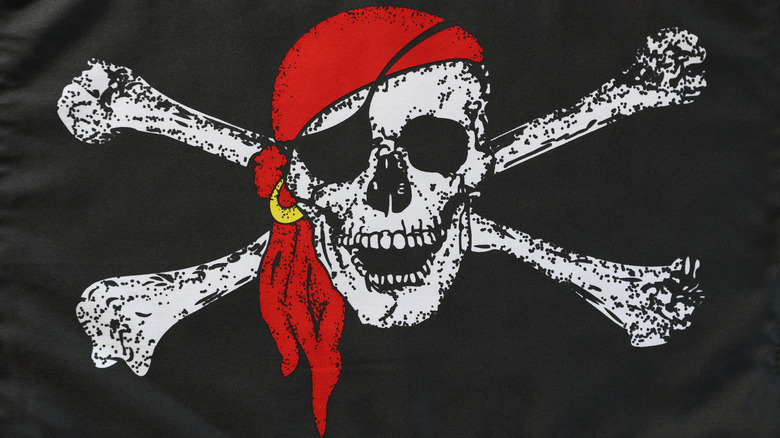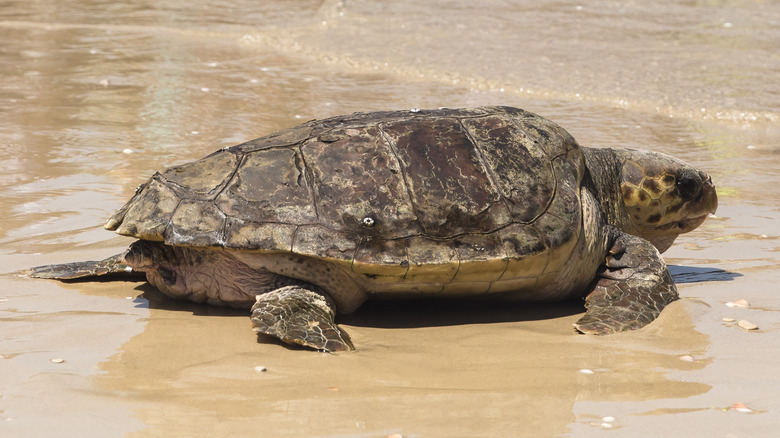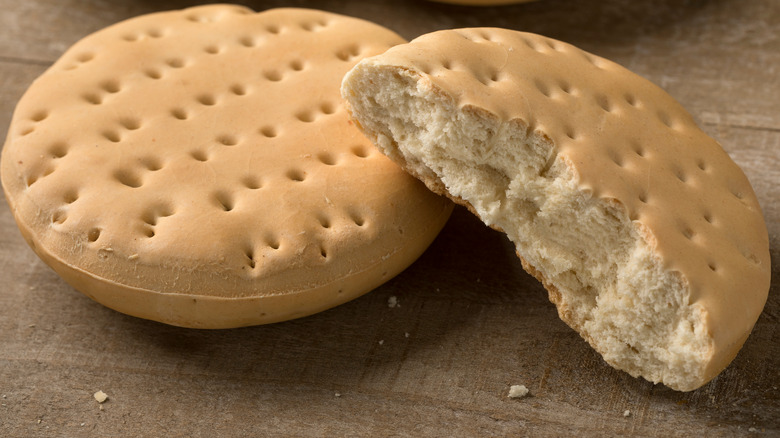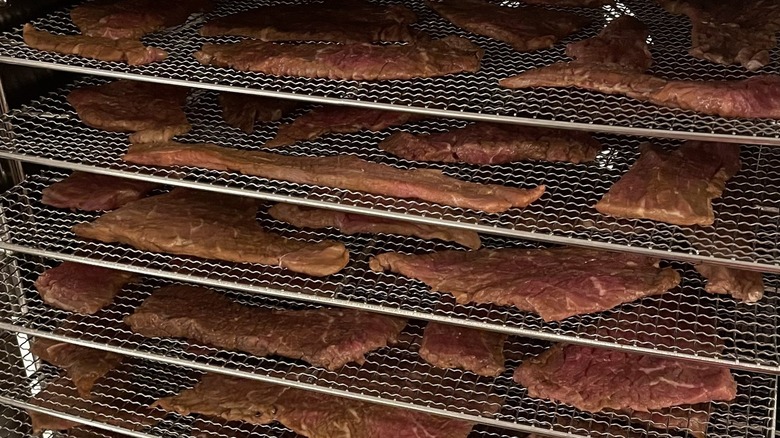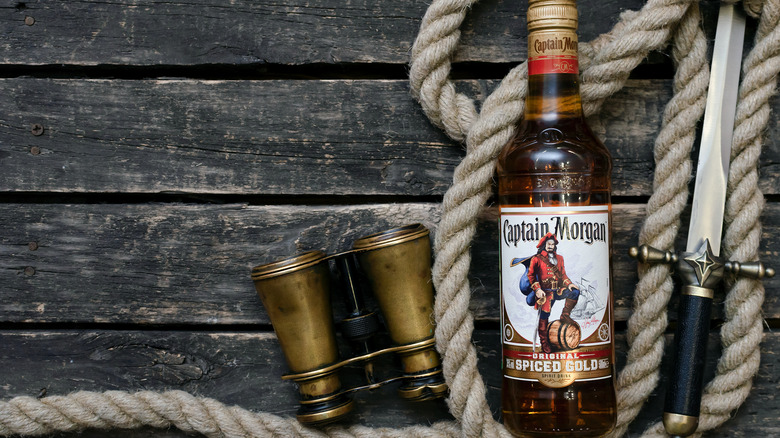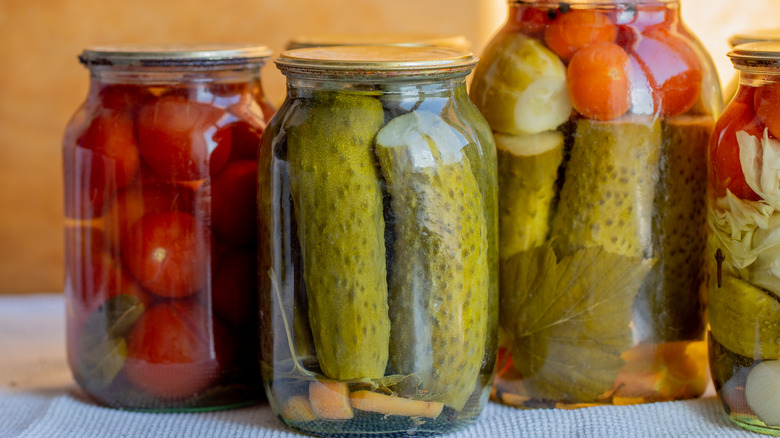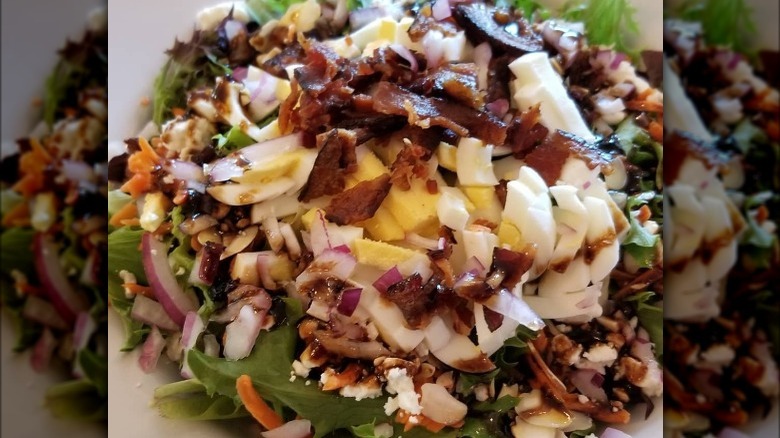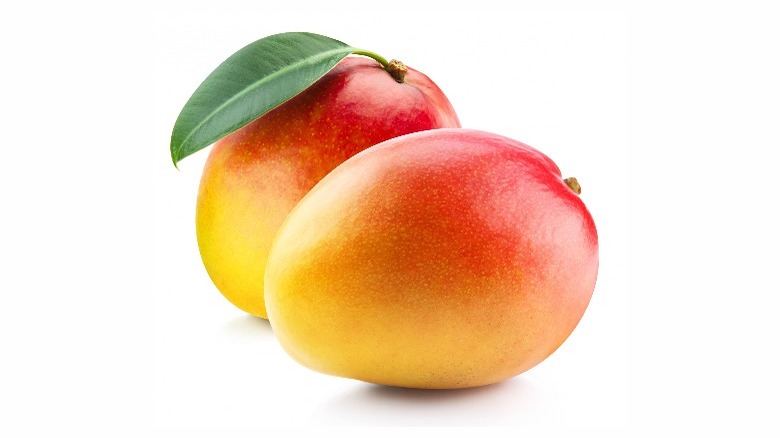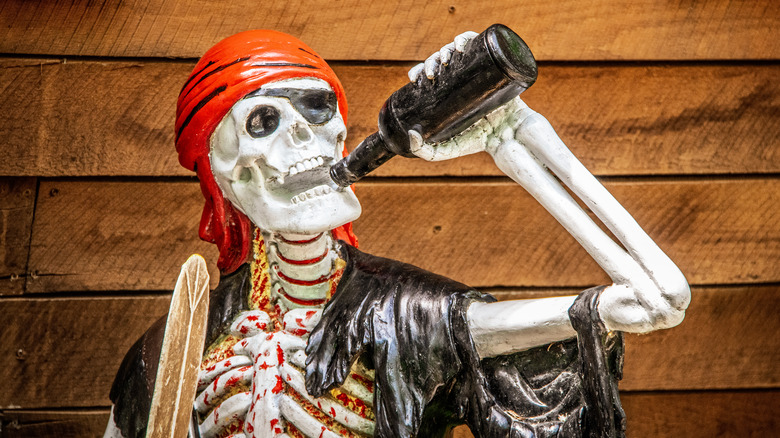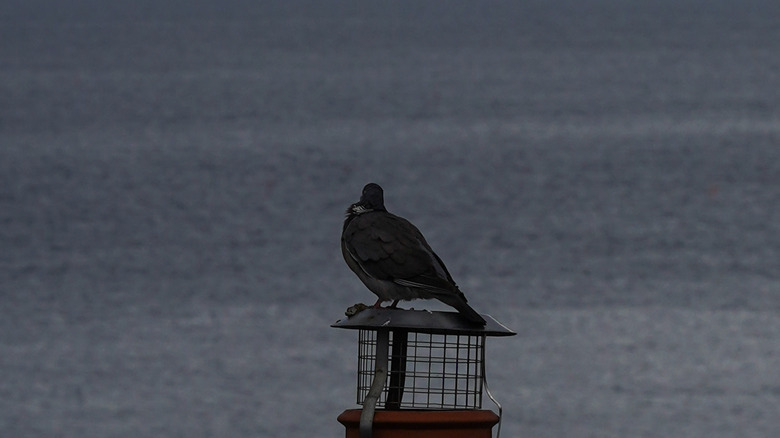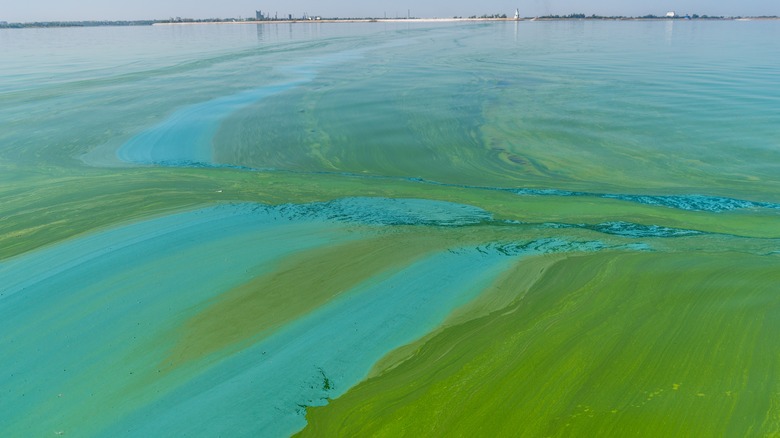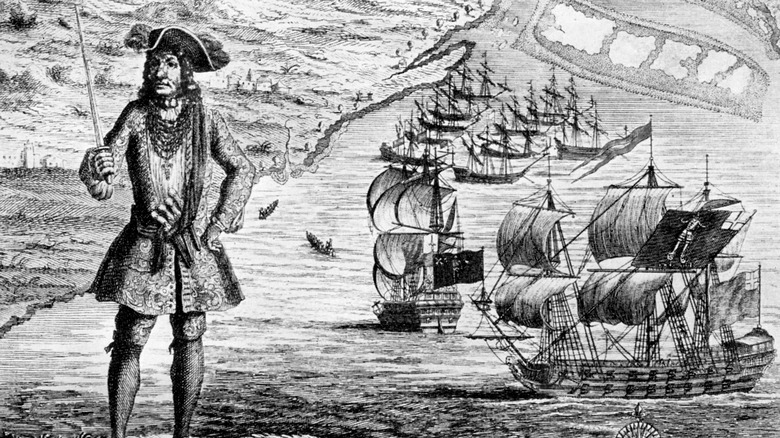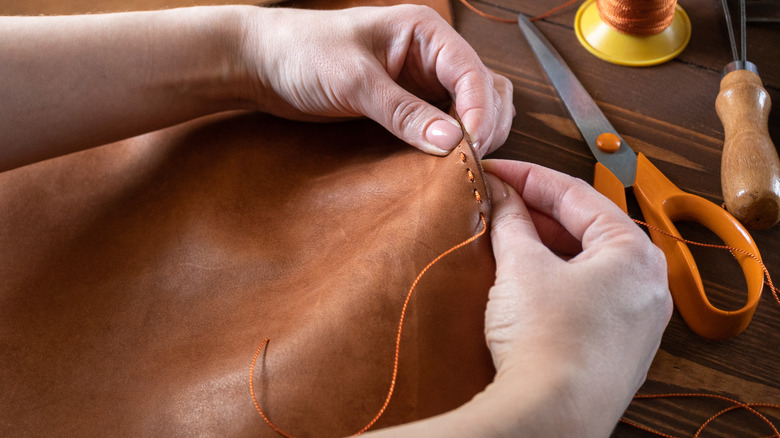What Did Caribbean Pirates Really Eat?
Yo ho, yo ho, a pirate's diet for me! Wait ... those aren't the words to the theme song from Disney's Pirates of the Caribbean ride. Those lyrics extol the virtues of a pirate's life, not diet, which is probably for the best. After all, the broad strokes of a Caribbean pirate's lifestyle are easily romanticized: but their diet? Well, that's another story, matey.
To be honest, the average person's perception of a Caribbean pirate is riddled with historically-inaccurate stereotypes, largely thanks to the less-than-authentic portrayal of pirates in Robert Louis Stevenson's classic novel "Treasure Island" (via Britannica). While some widely-known pirate stereotypes, such as a love for all things alcohol, are indeed accurate, others have little to no basis in reality (like the notion that pirates often searched for buried treasure) (via National Geographic).
We're not sure if anyone's under the impression that Caribbean pirates of yore (not the "Pirates of the Caribbean" from the 2000s and beyond) ate like seafaring kings. But, in reality, the coffers for those swashbuckling outlaw sailors were often devoid of anything exceptionally delicious (or nutritious).
So what did Caribbean pirates really eat, then? Well, you don't need to walk the plank to discover the details of a Caribbean pirate's daily diet. For the curious adventurer, simply raise a Jolly Roger flag, and set sail with us to discover what Caribbean pirates really ate.
Sea turtles
Somewhat similar to the notion that writers should only write what they know, Caribbean pirates could only eat what they had. A nautical lifestyle only left so many options for filling a buccaneer's plate, after all. But while the back-breaking labor and effort involved with catching fish over the side of a brig likely wasn't of interest to a pirate, scooping up sea turtles along the shore was, as the animal provided an easy, plentiful, and fresh source of meat (via Smithsonian).
The entire concept of consuming turtle meat in 2022 is undeniably taboo, but several hundred years ago? It was like chicken: so popular, in fact, that according to the Tampa Bay Times, George Washington served it at a celebratory feast following the end of the American Revolution. Even if eating turtles had been socially unacceptable at the time, though, the fact that pirates were known for their take whatever, whenever attitude means even a 17th-century PETA-type group wouldn't have fazed them.
Clearly, thumbing their nose at any sort of societal pressure wasn't behind the popularity of turtle meat among pirates. Since adult turtles weigh between 300-350 pounds on average, the aquatic animals simply made for an enormously bountiful food source (via National Ocean Service).
Hardtack biscuits
Bread, in its many forms and varieties, might be the most universally relied upon food staple in the world. The incredibly amenable food product has stood the test of time in the human diet for thousands of years for a reason.
Realistically, then, the fact that Caribbean pirates ate bread consistently is less surprising than if they hadn't. But life surrounded by water meant fresh bread was too easily susceptible to mold, so pirates, like many sailors of the day, had to settle for dry, hardtack biscuits instead (via Smithsonian).
According to the Texas Historical Commission, hardtack biscuits, though generally flavorless and often hard as a rock, were the preferred pantry bread for pirates because the cracker-like texture helped extend their shelf-life. Of course, while its dried-out composition made it better suited to the sea than other breads, hardtack biscuits weren't impervious to the elements.
More often than not, the fairly filthy living conditions on a Caribbean pirate ship meant hardtack would end up overrun with weevil bugs over time (via National Geographic). Actually, a bug infestation may not have fazed a Caribbean pirate as much as we'd imagine. After all, as Laura Sook Duncombe (author of "Pirate Women") told the Tampa Bay Times in 2017, pirates would often simply slam the biscuits to get rid of the bugs and then eat any remaining bugs since they were a great source of protein.
Dried beef
Anyone who has ever taken a long road trip knows certain foods are an absolute must-have. Frankly, loading up on items that travel well, like trail mix and beef jerky, is crucial to a successful trip. Of course, for Caribbean pirates, the presence of long-lasting food during their seemingly endless journeys was about more than a pleasant experience: it literally meant the difference between life and death. Hence, pirates prioritized food that would stay edible for long periods, including dried beef (via Tampa Bay Times).
Often sailing for weeks at a time without coming to shore, pirates understandably prioritized drier foods that remained edible over time in moist conditions. This, in turn, made salted and dried beef a common staple. But since Caribbean pirates making their way across vast stretches of the Atlantic Ocean didn't have access to full-service rest stops, they weren't snacking on dried meat products similar to Slim Jim or Jack's Links beef jerky.
The dried beef found aboard pirate ships was often compared to tree bark. According to National Geographic, some sailors were known to repurpose their dried beef rations into a belt buckle. In other words, dried beef was likely closer to hardtack from a pirate's point of view: A necessary evil for survival rather than a genuinely delectable treat.
Rum
When it comes down to what a Caribbean pirate really ate, it was basically yo ho ho ... and a bottle of rum! In that sense, we may owe a slight apology to Robert Louis Stevenson since those lyrics from the fictional sea shanty he included in "Treasure Island" are right on point. After all, as we noted at the beginning, the one Caribbean pirate stereotype no one can question involves their intense love of alcohol, with rum holding a particularly important place in the life of a pirate (via Wondrium).
Actually, while rum was undeniably beloved, it was far from the exclusive beverage of choice for real-life pirates of the Caribbean. Whether it was rum, beer, or any other available alcohol, remaining inebriated by any means necessary was simply the preferred distraction from the harsh realities of sea life during the 1700s and 1800s. In fact, according to 18th-century captain Nathaniel Uring, Caribbean pirates were a "rude drunken crew" who enjoyed drinking, sometimes for an entire week (via National Geographic)
The fact that rum was plentiful around the Caribbean and rarely went bad (unlike fresh water, which would become a slimy, scum-ridden liquid over time, which meant it was indeed just as popular with pirates as believed (via Smithsonian). In other words, you're in the clear with Captain Morgan, Ron Roberto, and every other pirate-themed rum brand.
Pickled meats and vegetables
The need to utilize preservation techniques for food products has drastically diminished since the advent of refrigeration. But Caribbean pirates weren't privy to those modern amenities, of course, so any way to reduce the risk of quick spoilage was key to survival. As a result, even when pirates were able to obtain meat and vegetables, they often did what they had to do in order to extend the shelf life of a food, including pickling any and all items at their disposal (via Smithsonian).
It wasn't just pirates that were prone to prefer pickled food products during the 17th and 18th centuries. After all, according to the book "Pirates of the Americas" by David Markey, pickling was one of the few food preservation techniques available to folks of that era. This means the likelihood of pickled meat and vegetables being aboard Caribbean pirate ships would be fairly high, regardless of any specific historical examples (via Tampa Bay Times).
Though pickling remains a popular culinary method for all types of foods, the ubiquitous presence of grocery and convenience stores provides a unique advantage to modern consumers. Frankly, while pickled meat or vegetables was preferred by Caribbean pirates to, say, hardtack biscuits, we can't imagine any buccaneers would reach for the pickle jar unless they absolutely had to.
Salmagundi
The overwhelming lack of genuinely appetizing options in a Caribbean pirate's diet makes you understand why they were so fond of booze. After all, at least if you're drunk, you can distract yourself from any hunger pangs in your stomach. But on occasion, pirates were able to feast on some truly intriguing selections. And nothing may top the favored stew of Caribbean pirates: a jumbled assembly of various foods known as salmagundi (via National Geographic).
Pirates' version of salmagundi was a meal made with virtually anything at their disposal, and it involved simmering a host of foods in a single pot filled with wine and spices (because, naturally, alcohol was the best cooking liquid). Among the common ingredients included in pirates' salmagundi were beef, fish, crab, cabbage, pigeon, and hard-boiled eggs, according to a pair of recipes from The New England Pirate Museum.
Part of the reason for the dish's popularity, according to the book "Pirates of the Americas" by David Marley, was that all crew members were expected to equally contribute and share pots of salmagundi, fostering camaraderie and deeper bond on board. In fact, the dish was so beloved among Caribbean pirates that the legendary Black Bart was actually dining on salmagundi the day of his capture and death.
Mangoes
Like the vast majority of produce sold in the U.S., the origin of mangoes isn't a top concern to most modern consumers. After all, the only thing that really matters is that the fruit is fresh, safe, and available at all times. But if you're wondering how mangoes were introduced to the American palate, you can actually thank Caribbean pirates, who first brought the tropical fruit to Florida in the 1700s (via WUSF Public Media).
Mangoes weren't just a favorite of Caribbean pirates for their sweet, creamy flavor, though. As history professor Kevin P. McDonald told the Tampa Bay Times in 2017, mangoes were likely a key item in battling scurvy: a well-known disease among 17th and 18th-century sailors caused by vitamin C deficiency. Since scurvy is believed to have killed an estimated two million sailors during that time period, the presence of mangoes on Caribbean pirate ships could have literally saved their lives (via U.S. Naval Institute).
Since few things in life taste better than fresh fruit, we're sure Caribbean pirates ate mangoes raw and unencumbered. But they also made use of the fruit in cooked dishes, as well, since a salmagundi recipe that was included in the book "Pirates of the Americas" by David Marley listed mangoes among a number of other ingredients.
Beer
Anyone with even a passing familiarity with Caribbean pirates knows those off-the-grid buccaneers were big fans of their alcoholic beverages (via Wondrium). But while any alcohol was welcomed with open arms aboard a pirate ship, it wasn't a simple matter of loving a lush lifestyle.
In fact, contrary to popular belief, the desire for debauchery was only part of the reason pirates consumed so much alcohol. Because unlike fresh water (which eventually became an algae-infested ooze), alcohol never spoiled on ships, which helped make beer a favorite beverage of Caribbean pirates (via Smithsonian).
Since alcohol was always on the menu, it's not hard to see why beer would have been a better day-to-day option for many Caribbean pirates than, say, rum. Beer contains far less alcohol than any liquor, after all, meaning a pirate crew slugging beer would have an easier time completing their work than one throwing back shots of liquor.
While beer was undoubtedly prominently consumed by Caribbean pirates, the reduced bang for your buck compared to hard liquor wasn't necessarily enough for some. In fact, according to famed pirate Blackbeard, ensuring his crew continued following orders wasn't possible with a weaker alcoholic drink, meaning beer alone was unlikely to satiate some pirates' boozy desires (via National Geographic).
Pigeons
We'd bet there's a decent chance you furrowed your brow upon reading the title for this slide. Pigeons? Really? Well, for starters, the notion of eating a pigeon isn't entirely unheard of since the fine-dining menu staple, squab, is a common type of pigeon. Beyond that, though, it really can't be surprising that Caribbean pirates ate pretty much anything that was available to them. This includes one of the main ingredients listed in recipes for the common pirate dish salmagundi: chopped pigeon (via National Geographic).
Now, to be perfectly honest, beyond pigeon appearing as a listed ingredient for several pirate-like salmagundi recipes (including one listed by the New England Pirate Museum), there's not a ton of evidence to illustrate Caribbean pirates were routinely catching and roasting pigeons.
But while history professor Kevin P. McDonald told the Tampa Bay Times in 2017 that he wasn't aware of any pigeon-specific preferences, he also noted that the pirates were likely partial to eating any bird that they could hunt.
Frankly, we have to wonder if any pirates partial to pigeons also owned pet parrots. If so, who could fault those Caribbean buccaneers for finding a less emotionally difficult meal to satiate their craving?
Algae-infested water
Every living person recognizes the unparalleled importance of water to staying alive, including the well-known fact that the human body consists of roughly 60% water. Caribbean pirates weren't unaware that ingesting water was needed to survive. But the wooden casks that stored fresh water were prone to internal seepage, which left only slimy, algae-infested water for pirates to consume (via Wondrium).
This, quite frankly, was likely the main underlying cause for Caribbean pirates' preference for alcohol over water. Liquor doesn't spoil, at least not the same or as quickly as plain water, meaning the only real option was alcohol ... or water swimming with green, toxic algae (via Smithsonian).
Even still, Caribbean pirates didn't entirely avoid the algae water, mainly because they couldn't. After all, the human body can only survive up to three days without drinking water. Oftentimes, then, pirates would work around the issue by mixing some sort of alcohol with water before consumption, hoping that would render the tainted water safe.
Since Caribbean pirates weren't dying en masse from thirst or poisoning, the algae-infested water clearly wasn't the most dangerous thing in the world. But it certainly wouldn't have been a selling point to anyone considering becoming a pirate.
Bumbo
By now, we're likely well acquainted with the fact that Caribbean pirates indulged in alcohol for reasons beyond the simple desire to get sloshed. But just because pirates often drank alcohol because fresh water was less than plentiful by itself doesn't mean they exclusively downed cup after cup of beer or straight rum. In fact, one of the most popular beverages consumed by Caribbean pirates was bumbo, a spiced liquid concoction including water, sugar, nutmeg, and, of course, rum (via Wondrium).
Compared to other common components of a Caribbean pirate's diet, bumbo actually sounds somewhat enticing. Quite frankly, the combination of ingredients makes bumbo seem like a less-rich holiday season companion to eggnog, one that could work well as a pirate-themed alternative to the creamy cocktail, according to CultureMap Houston.
All things considered, we're not entirely sure why bumbo hasn't stood the test of time or remained a popular choice through the centuries. But when we're looking for a lighter rum-centric beverage this December, we think we'll skip apple cider and mix ourselves a classic Caribbean pirate bumbo instead.
Leather shoes and bags
Since pirates were nothing more than flesh-and-blood humans like everyone else, they were prone to the same potential hardships as anyone else: mainly, the need to eat to survive. And, like any other person staring down starvation, Caribbean pirates sometimes found themselves turning to any possible food. In one instance, in fact, a pirate crew resorted to eating leather bags and shoes to stave off death (via Tampa Bay Times).
Now, while comparing a piece of meat to shoe leather is a universally-recognized negative description, maybe we shouldn't be as disgusted by the tales from Henry Morgan's ship. After all, leather generally comes from the skin of an animal, and some leather products may, in fact, be legitimately safe for consumption.
Plus, back in 1670, when the famous 17th-century pirate's crew was desperate enough to literally shred and fry their leather bags, far fewer chemical, potentially-poisonous preservatives were used in making leather (via National Geographic). In other words, it may not have been tasty, but it wasn't necessarily deadly, either.
Additionally, while we weren't able to find any specific details about how the leather-eating crew members fared after their unusual meal, it seems as though the leather gambit may have worked. After all, according to Britannica, the Welsh-born Morgan lived another two decades after his crew's fateful ingestion of their leather items.
